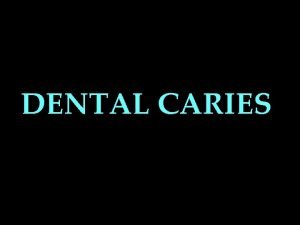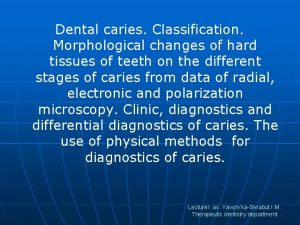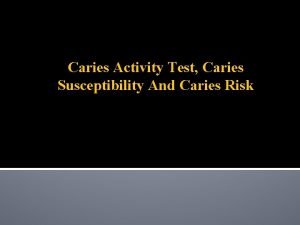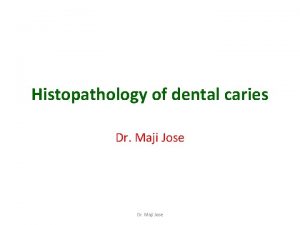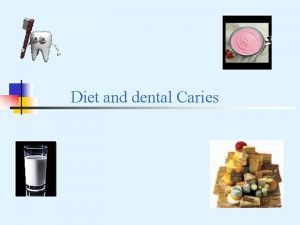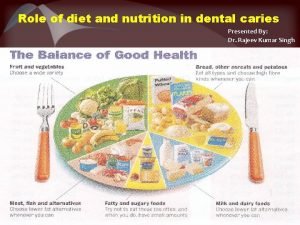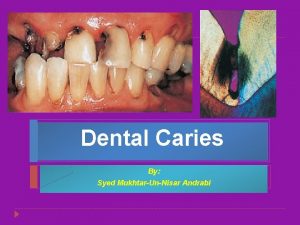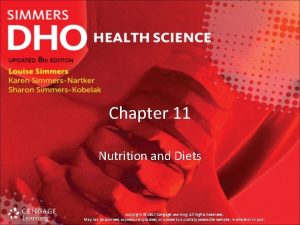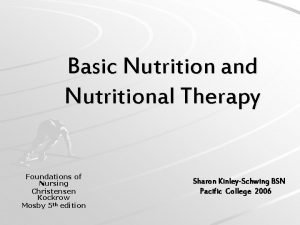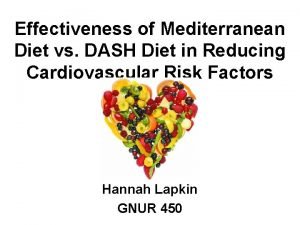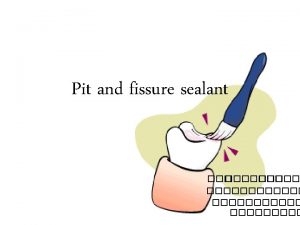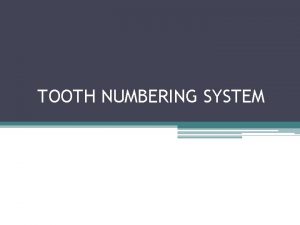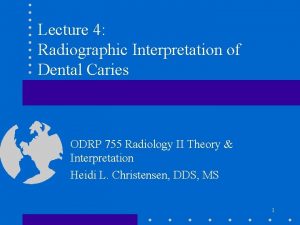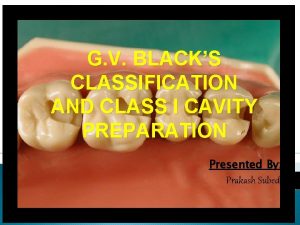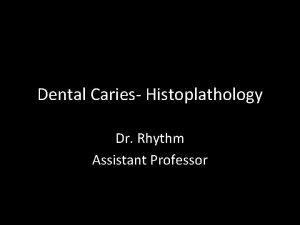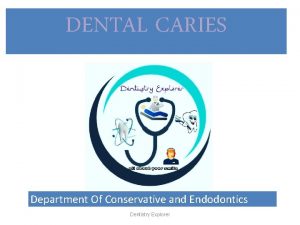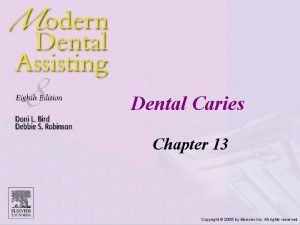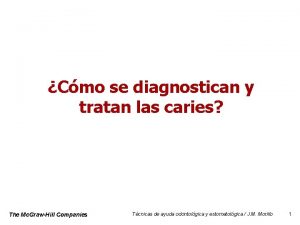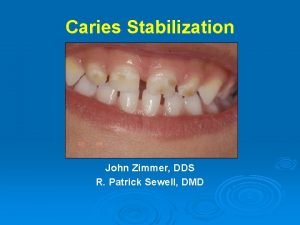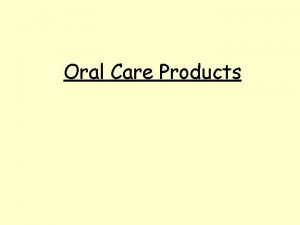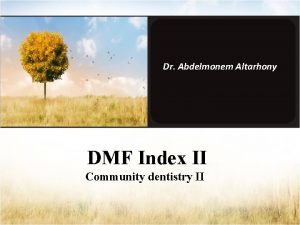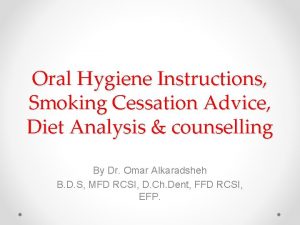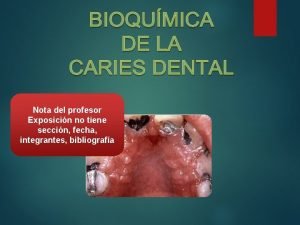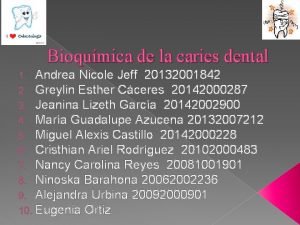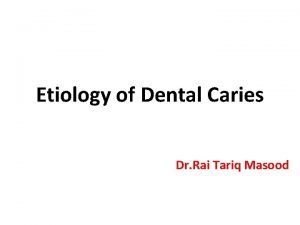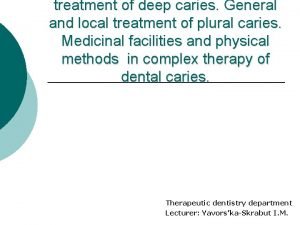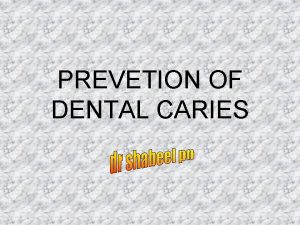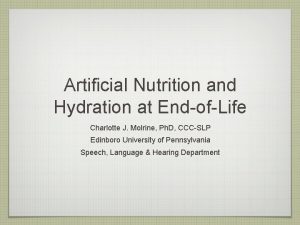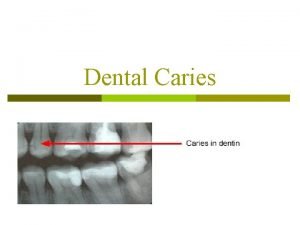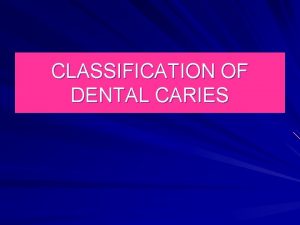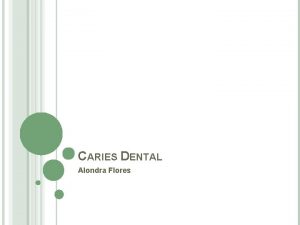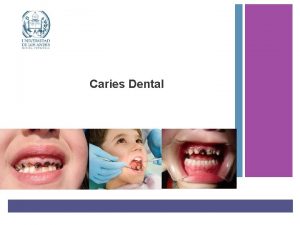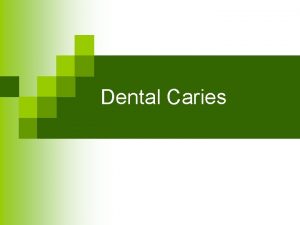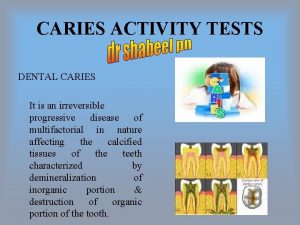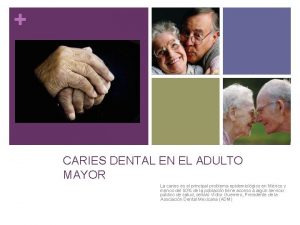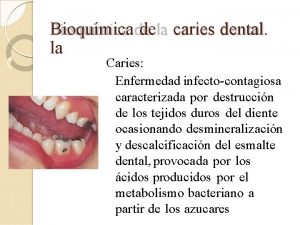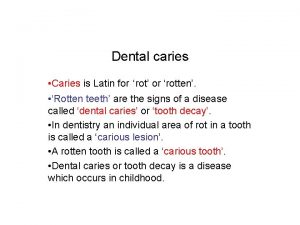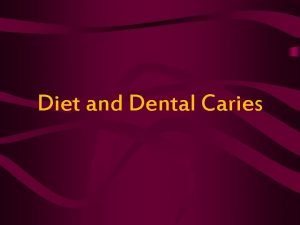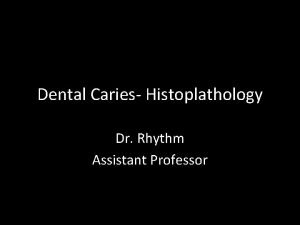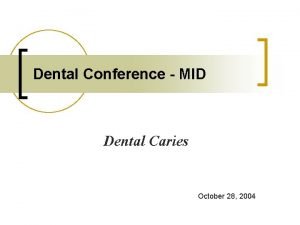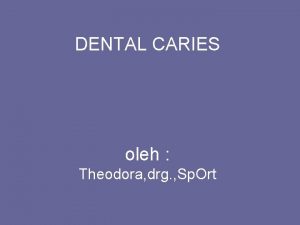Role of diet and nutrition in dental caries






































- Slides: 38

Role of diet and nutrition in dental caries Presented By: Dr. Rajeev Kumar Singh

Diet Food Any substance which Diet is referred to when taken into as "food and the organism drink may be used either to supply energy or to build tissue. regularly consumed. ” Diet refers to the pattern of food intake Balanced diet Diet which contains a variety of foods in such quantities and proportions that the need for energy is adequately met for maintaining health , vitality and general well being


Nutrition Ø The process of nourishing or Ø Substances in food that are being nourished, especially the essential for energy , growth and process by which a living normal functioning of the body organism assimilates food and maintenance of life. uses it for growth and for replacement of tissues. Ø Nutrients The science or study that deals with food and nourishment, especially in humans. 1) Macronutrients : carbohydrates, fats & proteins 2) Micronutrients : minerals and vitamins

Nutritional Status & Dental Caries Ø Ø

Systemic effects Development of teeth Quality & quantity of saliva Improved host resistance Improved function

Local effects • Influencing metabolism of oral flora • Modifying salivary flow rates • Quality of saliva

Carbohydrates Monosaccharides eg. Glucose, fructose Oligosaccharides eg. Sucrose, lactose Polysaccharides eg. Starch, glycogen

Carbohydrates and caries Ø Ø

Abilities of natural and refined carbohydrates to cause dental caries Ø Ø Ø

Sucrose (cane sugar) • Disaccharide (Glucose+ Fructose) • Constituent of cane sugar, beet sugar & pineapple • Most commonly used table sugar supplying calories

Sucrose “arch-criminal of dental caries” Ø Ø

STARCH COOKED STARCHY FOOD WHEN COMBINED WITH REFINED SUGARS (DOUGH NUT , PASTRY, POTATO CHIPS) RESULTS IN PLAQUE FORMATION, DENTAL CARIES, PERIODONTAL DISEASE Ø

Vitamins Ø Ø Ø

Fruits Ø Ø

Breastfeeding Ø Ø

Minerals Ø Ø Ø

Foods That Cause the p. H to Fall Below 5. 5 Ø Apple drink Ø Apricots, dried Ø Bananas Ø Beans, baked Ø Beans, green canned White bread Ø Whole wheat bread Ø Caramels Ø Chocolate milk Ø Cola Ø Crackers, Cream cheese Ø Doughnuts Gelatin-flavored dessert

Noncariogenic sucrose substitutes Ø Ø


Sugar substitutes CALORIC / NUTRITIVE Can be metabolized by body to yield energy Add bulk to food Sugar alcolhols Glycitols polyols NON-CALORIC / SWEETENERS Aspartame Cyclamate Saccharine acesulfame

Important factors in caries determination Constituents Physical properties of food Natural versus Processed food Acidity of foods

Food constituents Ø Ø Ø

Physical properties of food Mechanical properties Hardness, cohesiveness Viscosity, adhesiveness Geometric properties Particle size Shape Others Moisture Fat content

Natural versus processed food Ø Ø

Acidity of foods Ø Ø

DIET COUNSELING

Diet counseling IT IS THE ACT OF PROVIDING ADVISE AND GUIDANCE TO A PATIENT OR THE PATIENTS FAMILY REGARDING THE TYPE OF FOOD THAT SHOULD BE TAKEN AND ITS RELATION TO BOTH HEALTH AND DISEASE

NEED FOR COUNSELING Ø To modify dietary habits, particularly ingestion of sucrose containing foods, in forms and amounts that promote caries Ø To correct dietary imbalances that could interfere with the patient’s general health and well being

AAPD (2005) Recommends ü Breast feeding of infants to ensure best possible health , developmental and psychosocial outcomes ü Educating people about association between consumption of carbohydrates and caries frequent ü Educating people about other health risks associated with excess consumption of carbohydrates , fats and sodium

PATIENT SELECTION ü Patient should have a positive attitude and be willing and to make long- term efforts towards improvement of oral status through dietary means. ü Should have a demonstrable need for dietary improvement.

GUIDELINES FOR COUNSELING Likes and dislikes Personal data GATHERING INFORMATION Suggest diet diary Cause of problem

STEPS OF A DIET COUNSELING PROGRAMME 1) First appointment - Identification of high-risk patients. - Maintaining the diet diary 2) Second appointment - Evaluation of the diet diary - Develop an action plan - Well balanced diet - Use of Nutritive sugar substitutes 3) Third appointment - Evaluation of the progress

DIET DIARY Ø Record every food item consumed solid or liquid during 6 consecutive days Ø Record food consumed during mealtimes, between meals. Ø Use appropriate household measures to measure the amount of food. Ø The kind of food and how it was prepared. Ø Addition to the food in cooking or at table

EVALUATE AND INTERPRET INFORMATION Nutritional adequacy of diet Amount of sugary foods Frequency of sugary foods Personal and social history Medical history Systemic and environmental factors

DEVELOP AND IMPLEMENT A TREATMENT PLAN Gradual, qualitative changes in diet Gradually eliminate sugary foods Avoid patient dislikes Prescribed diet should vary from normal diet pattern as little as possible Nutritionally balanced diet Increase intake of protective and detergent foods – fruits, vegetables, cheese, etc

ACTIVE PARTICIPATION OF PATIENT Patient encouraged to involve himself in diet monitoring and suggest changes in menu REGULAR FOLLOW – UP To monitor progress Make changes To clarify doubts To motivate and encourage

Thank You
 Caries latin
Caries latin Forward and backward caries
Forward and backward caries Senile caries meaning
Senile caries meaning Caries that spurts up with advancing age
Caries that spurts up with advancing age Forward caries and backward caries
Forward caries and backward caries Lactobacillus count test
Lactobacillus count test Tomes fibres
Tomes fibres Vipeholm study ppt
Vipeholm study ppt Dental caries
Dental caries Turbid dentin
Turbid dentin Test chapter 11 nutrition and diets
Test chapter 11 nutrition and diets Chapter 11 nutrition and diet
Chapter 11 nutrition and diet Fundamentals of nursing nutrition
Fundamentals of nursing nutrition Dash diet or mediterranean diet
Dash diet or mediterranean diet C# azure worker role example
C# azure worker role example Role taking krappmann
Role taking krappmann Statuses and their related roles determine the structure
Statuses and their related roles determine the structure Caries risk assessment form
Caries risk assessment form Fdi tooth numbering system
Fdi tooth numbering system Cervical burnout cause
Cervical burnout cause Caries ad pulpam penetrans
Caries ad pulpam penetrans Line angles and point angles in class 2 cavity
Line angles and point angles in class 2 cavity Zones of dentinal caries
Zones of dentinal caries Mount and hume classification
Mount and hume classification Elsevier
Elsevier Que es caries
Que es caries Interim therapeutic restoration
Interim therapeutic restoration Detal caries
Detal caries Dmf dentistry
Dmf dentistry Root caries
Root caries Teoria del glucogeno de la caries
Teoria del glucogeno de la caries Teoria proteolitica
Teoria proteolitica Texas health steps quick reference guide
Texas health steps quick reference guide Caries mesial incipiente
Caries mesial incipiente Hidden caries
Hidden caries Rairena
Rairena Undermined enamel
Undermined enamel Medical model of caries management
Medical model of caries management Pros and cons of artificial nutrition and hydration
Pros and cons of artificial nutrition and hydration



